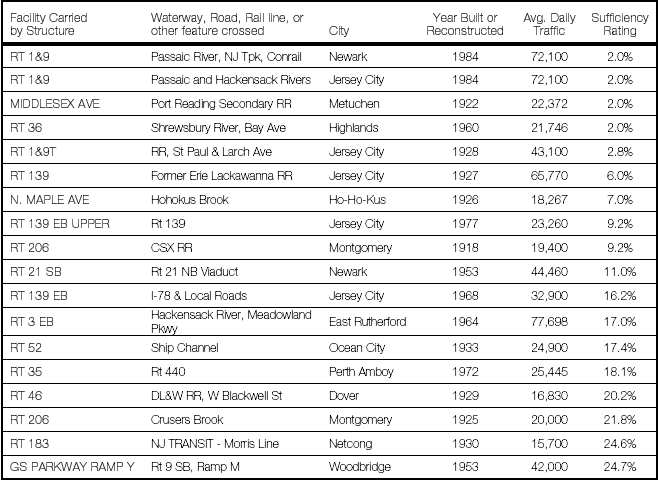
Following on the heels of a letter from the Tri-State Transportation Campaign, Environment New Jersey, and NJPIRG urging Governor Christie to redirect the billions in transportation funds that had been slated for the Access to the Region’s Core project to transit and repair projects, a new TSTC report identifies more than 200 deficient major New Jersey bridges.
Those bridges carry nearly eight million cars and trucks daily, according to the report, “More than a Bandage for New Jersey’s Crumbling Bridges: Making the Case for a Long-Term and Sustainable TTF.” Many are in need of immediate repair or reconstruction — but the expected bankruptcy of New Jersey’s Transportation Trust Fund threatens to derail progress on improving bridges and other critical infrastructure. Beginning in July 2011, all of the gas tax and other revenue flowing into the TTF will go to service payments on decades’ worth of past borrowing.
The majority of New Jersey’s structurally deficient bridges are concentrated in the heavily populated counties of northern New Jersey. Bergen County tops the list with 26 structurally deficient bridges, followed by Essex and Morris Counties with 20 and 19 structurally deficient bridges, respectively. But as a percentage of total major bridges, rural Sussex and Warren counties, each with far fewer major bridges than their more urbanized neighbors, rank at the top with 14 percent of major bridges rated structurally deficient.
States are also required to calculate a sufficiency rating based on nearly two dozen factors related to a bridge’s condition and use. Tri-State ranked all 202 of New Jersey’s structurally deficient major bridges by this category, identifying 18 with a very low sufficiency rating of less than 25% (the sufficiency rating can range from 0 to 100%):

Many of these bridges, like the Pulaski Skyway, are notorious to drivers for their potholes and craters. Others suffer from problems not apparent to the average motorist, but no less worrisome. Some of the bridges date from World War I.
While the term “structurally deficient” does not necessarily indicate that a bridge is in danger of collapse, it is an indication that a particular bridge is in need of repair or reconstruction in the immediate or near future.
NJDOT has made steady progress on a legislatively mandated goal of reducing the backlog of deficient bridges. But according to the agency’s 2010 Statewide Capital Investment Strategy, annual spending of more than $850 million is necessary to make a significant dent in the state’s backlog. Without a solvent Transportation Trust Fund, continued progress is likely to stall.
Tri-State’s report makes the following recommendations to improve New Jersey’s bridges:
- Identify a new long-term sustainable funding solution to the Transportation Trust Fund revenue crisis.
- Continue the state’s fix-it-first policy by fixing existing infrastructure before building new roads and bridges.
- Require NJDOT to make significant and documented progress on reducing the backlog of deficient bridges.
- Maintain funding for transit projects and operations in order to curb traffic and reduce future wear-and-tear on bridges and other infrastructure.
- Redirect available ARC funding for transit and repair projects.
The report and a Google Map showing the exact location of each structurally deficient major bridge, as well as details about each bridge are available on TSTC’s website.

The number 3 bridge on your list (Middlesex Ave – NJ 27 – in Metuchen) was just completely rebuilt and reopened. Work is in progress (or has, perhaps, been completed) on a number of other bridges on your top 18 list including Truck 1&9 in Jersey City, NJ 139 in Jersey Cit, and US 46 in Dover.
It is very important that TSTC continue its fix-it first advocacy; but it is also important that you acknowledge that some progress is being made by making sure information you present is up-to-date.
Thanks for your comment, Rob. We will point out in the article that our report relies on the most recent federal data, which dates from 2009.
We are aware that some of the bridges on this list are now in various stages of design, construction, etc. In fact, it would be shocking if none of them were, given that they are the ones most in need of repair! (We did say in our report that some of the bridges were included in previous NJDOT capital plans.)
That NJDOT has been able to fix some of its worst bridges this year is a testament to the agency. The question is whether it will be able to do so in the future, given the prospect of a bankrupt Transportation Trust Fund.